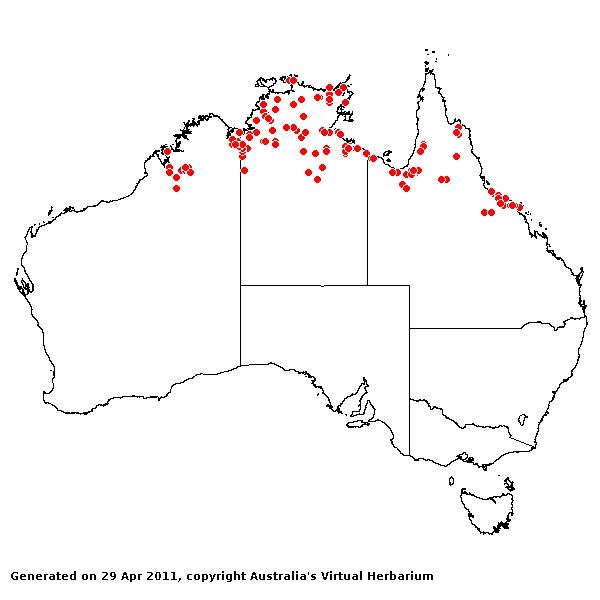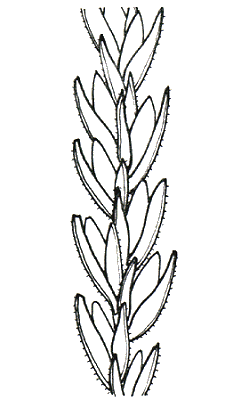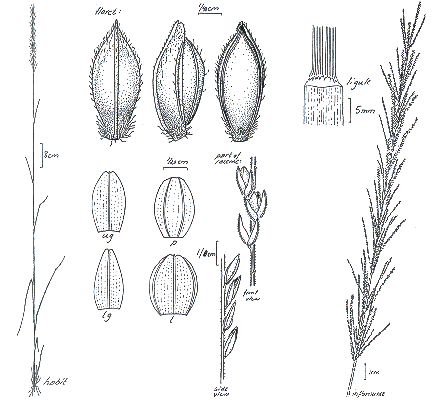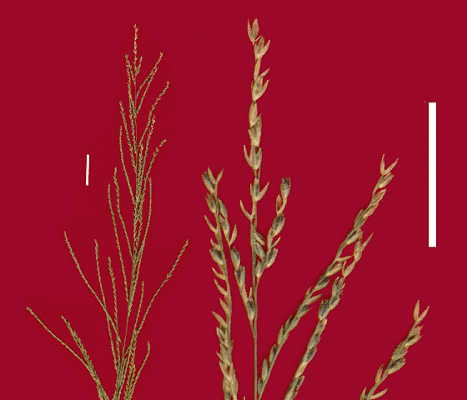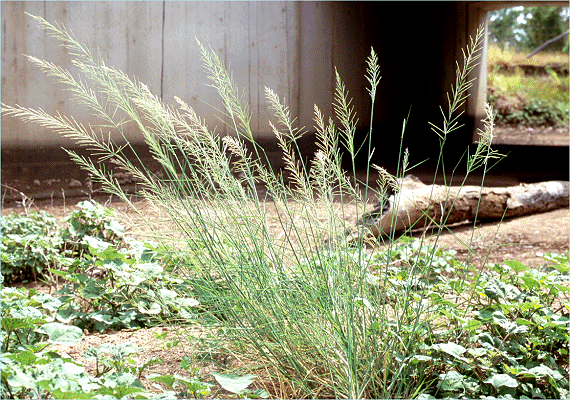Dinebra neesii (Thwaites) P.M.Peterson & N.Snow, Ann. Bot. 109: 1326 (2012).
Classification. (GPWG 2001) : Subfamily
Chloridoideae. Cynodonteae.
Basionym and/or
Replacement Name: Cynodon neesii
Thwaites, Enum. Pl. Zeyl. 371 (1864).
Type of Basionym or
Protologue Information: HT: Thwaites C.P. 3749, Ceylon: Eastern Prov.: Trincomalee
(PDA).
Key references
(books and floras): [1810]. R.Brown, Prodromus (187 as Cynodon
polystachyon), [1878] G.Bentham, Flora Australiensis 7 (617 as Leptochloa
polystachya), [1952] C.A.Gardner, Flora of Western Australia 1 Gramineae
(211 as L. brownii), [1969] E.E.Henty, Manual Grasses New
Guinea (121 as L. virgata), [2002] D.Sharp & B.K.Simon, AusGrass,
Grasses of Australia as Leptochloa.
Illustrations:
[2005] K.Mallet (ed.), Flora of Australia 44B: Poaceae 3
(Fig. 79D), as Leptochloa.
Habit. Annual
or perennial. Culms stature slender to delicate, 60–150 cm tall. Mid-culm nodes
glabrous. Lateral branches sparsely branched. Leaf-sheaths smooth or
scaberulous. Ligule an eciliate membrane, 2–4 mm long, lacerate. Leaf-blades
linear or lanceolate, flat or involute, 5–35 cm long, 2–6 mm wide. Leaf-blade
surface scabrous.
Inflorescence.
Inflorescence compound, a panicle of racemes. Racemes numerous, 60–70, erect or
spreading, straight or arcuate, 2.5–9 cm long. Central inflorescence axis 15–45
cm long.
Spikelets.
Spikelets sessile. Fertile spikelets 1 or more flowered, with 1 fertile floret,
comprising 1 fertile floret(s), with a barren rachilla extension, oblong,
laterally compressed, 1–1.8 mm long.
Glumes. Glumes
similar. Lower glume lanceolate, membranous, keeled, 1-keeled, 1 -nerved. Upper
glume elliptic, 1–1.9 mm long, membranous, keeled, 1-keeled, 1 -nerved.
Florets.
Fertile lemma 1–1.5 mm long, keeled, 3 -nerved. Lemma surface glabrous or
indumented. Lemma apex entire, mucronate. Palea 2 -nerved. Grain 0.5–0.75 mm
long.
Continental
Distribution: Tropical Asia and Australasia.
Australian
Distribution: Western Australia, Northern Territory, Queensland.
Western Australia: Gardner, Dampier. Northern Territory: Darwin & Gulf, Victoria
River, Barkly Tableland. Queensland:
Burke, Cook, North Kennedy.
Notes.
Considered to be a potential weed of tropical crops cultivated under flood
irrigation, for in Ceylon
and Java the species is a common component of rice fields and similar
disturbed, wet areas.
The species is recognized by 1-flowered
spikelets, terete grain, roughened glumes long relative to the spikelet, hairy
lemma and palea, prominent ligule and elongated rather dense panicle.
Native;
in Australia the species
occurs N of 20°S in W.A., N.T. and Qld; distributed in Australia, Ceylon and Java. Almost invariably,
plants grow on cracking clay plains and floodplains, usually in gilgais and
similar seasonally flooded depressions. In saline situations, the species is
often associated with Sporobolus virginicus (L.) Kunth.

